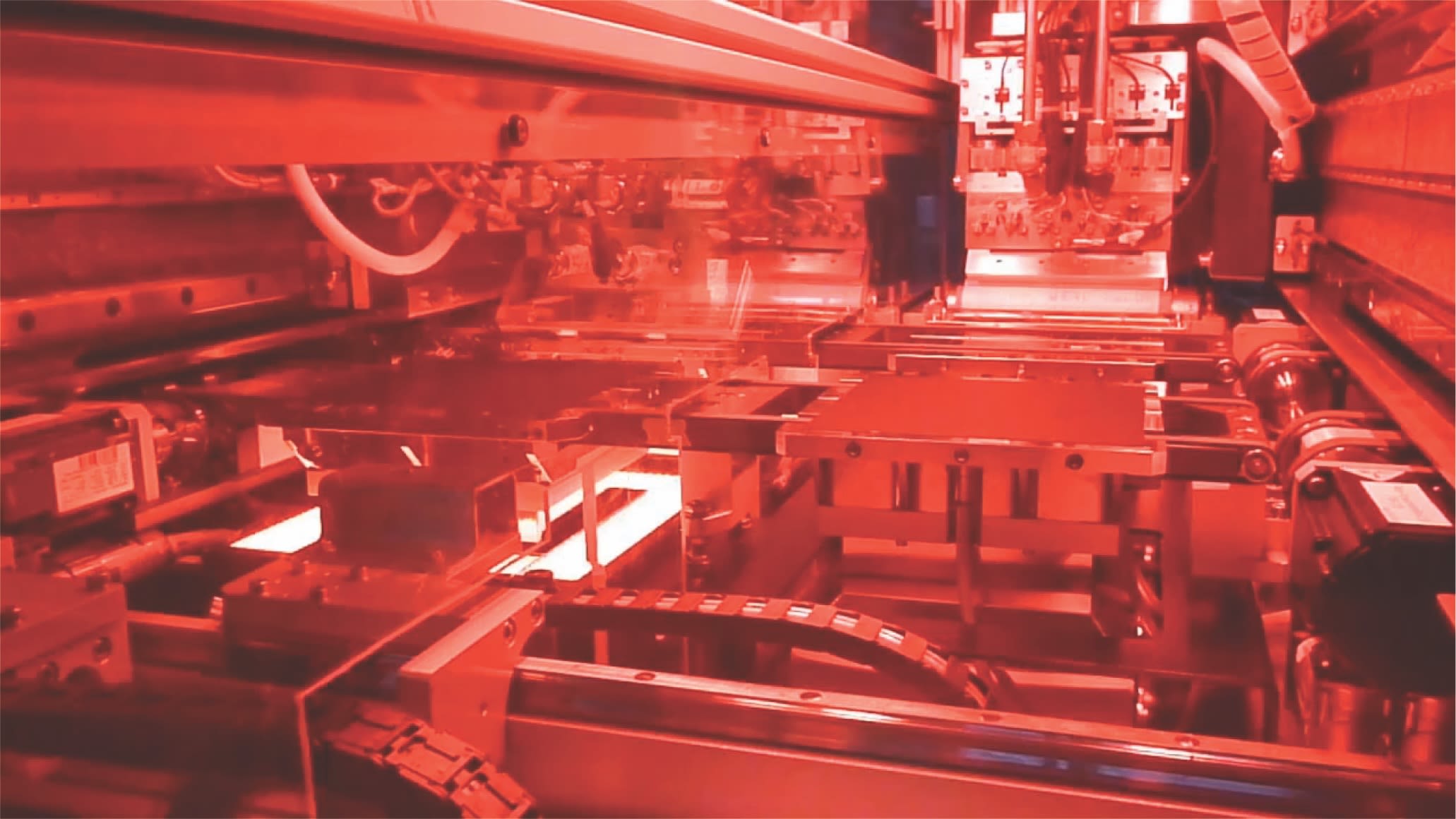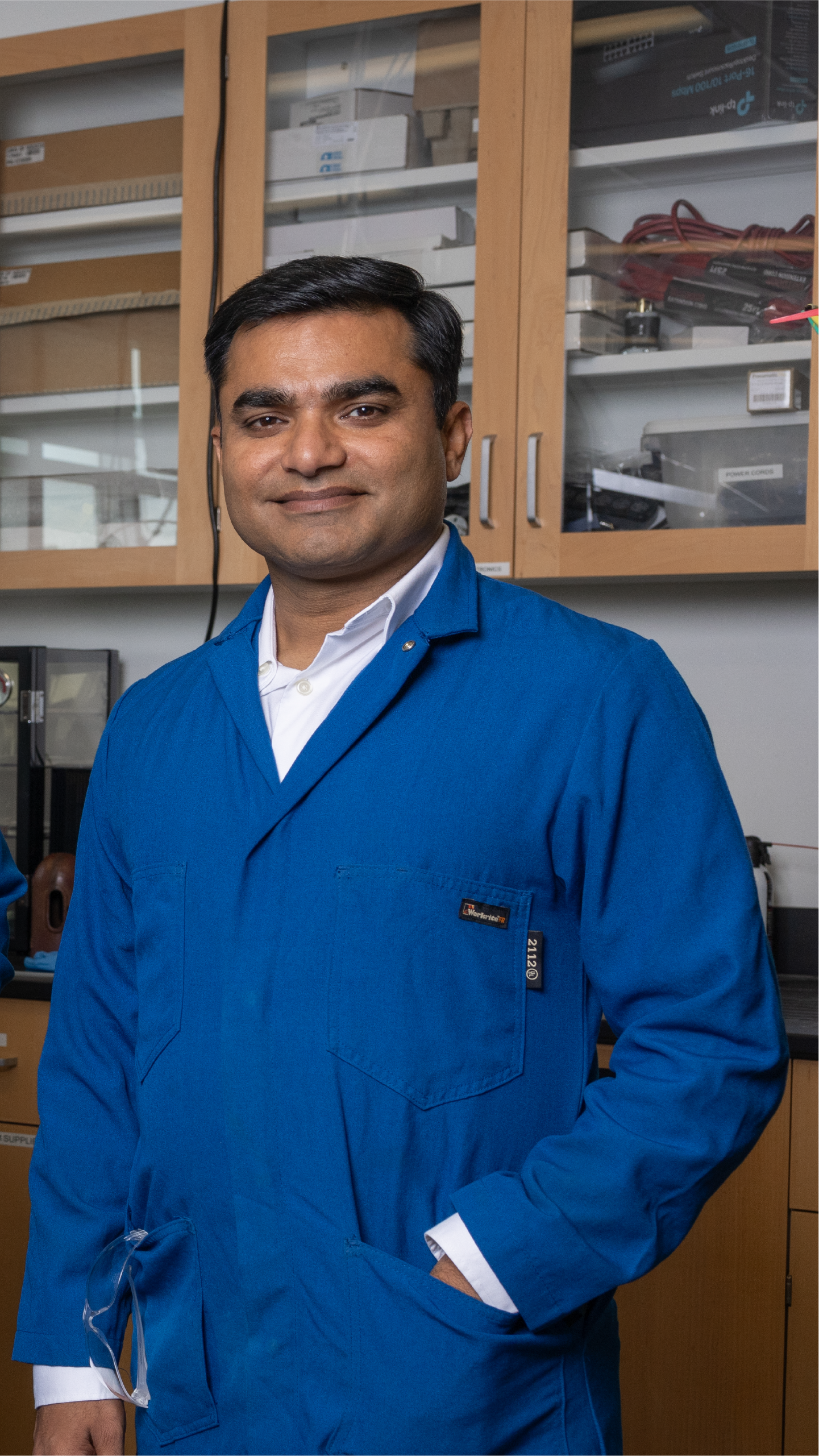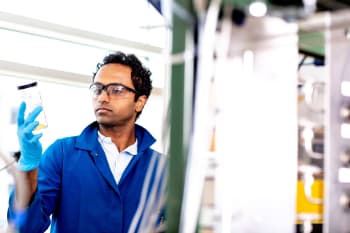Revolutionizing Tech to Produce Sustainable Fuel

SRI AND UNIVERSITY OF HOUSTON TO RECEIVE $3.6M TO DEVELOP A MICROREACTOR TO CONVERT CARBON DIOXIDE TO METHANOL USING RENEWABLE ENERGY
A University of Houston-affiliated project that has the potential to transform sustainable fuel production was selected to receive $3.6 million from the U.S. Department of Energy’s Advanced Research Projects Agency-Energy. Led by SRI, a leading nonprofit research institute, the project titled “Printed Microreactor for Renewable Energy Enabled Fuel Production” or PRIME-Fuel, aims to develop a modular microreactor technology that converts carbon dioxide into methanol using renewable energy sources. UH, a Carnegie-designated Tier One public research institution, is contributing essential research needed for the project.
This is part of ARPA-E’s $41 million Grid-free Renewable Energy Enabling New Ways to Economical Liquids and Long-term Storage program, otherwise known as the GREENWELLS program, which includes 14 projects to develop technologies that use renewable energy sources like wind and solar to produce sustainable liquid fuels or chemicals, which can be transported and stored similarly to gasoline or oil. Selected teams will develop systems that use electricity, carbon dioxide and water at renewable energy sites to produce renewable liquid renewable fuels that offer a clean alternative for sectors like transportation.
Researchers Rahul Pandey, senior scientist with SRI and principal investigator (L), and Praveen Bollini (R), a University of Houston chemical engineering faculty, are key contributors to the microreactor project.
Researchers Rahul Pandey, senior scientist with SRI and principal investigator (L), and Praveen Bollini (R), a University of Houston chemical engineering faculty, are key contributors to the microreactor project.
“Renewables-to-liquids fuel production has the potential to boost the utility of renewable energy all while helping to lay the groundwork for the Biden-Harris Administration’s goals of creating a clean energy economy,” said U.S. Secretary of Energy Jennifer M. Granholm in an ARPA-E press release.
Low-carbon fuels cost about $10 per gallon, but using cheaper electricity from sources like wind and solar can lower production costs. It will also create opportunities for smaller communities with renewable resources to invest in affordable and cleaner long-term energy storage solutions.
“We believe that PRIME-Fuel will play a critical role in the transition to sustainable energy solutions,” said Rahul Pandey, senior scientist with SRI and principal investigator on the project. “By harnessing renewable energy to produce methanol, we can help combat climate change while providing valuable resources for various industries by leading to cost-effective and sustainable methanol production.”
Vemuri Balakotaiah and Praveen Bollini, faculty members of the William A. Brookshire Department of Chemical and Biomolecular Engineering, are co-investigators on the project. Pandey, a University of Houston alumnus, earned his Ph.D. from the department in 2015. This shared connection played an integral role in bringing the three together on this project.
“As a proud UH graduate, I have always been aware of the strength of the chemical and biomolecular engineering program at UH and kept myself updated on its cutting-edge research,” Pandey said. “This project had very specific requirements, including expertise in modeling transients in microreactors and the development of high-performance catalysts. The department excelled in both areas. When I reached out to Dr. Bollini and Dr. Bala, they were eager to collaborate, and everything naturally progressed from there.”
SUSTAINABLE PRODUCTION OF METHANOL
While methanol can be harmful if misused, its sustainable production offers significant benefits. Methanol can serve as a versatile energy carrier and high-energy density liquid fuel, potentially replacing fossil fuels in various applications. It is also a valuable chemical feedstock that is easily stored and transported.
“The technology developed here will provide a means for the distributed, low-cost production of methanol using stranded renewable sources of energy, including those in underdeveloped countries.”
“Methanol is a platform chemical, meaning a lot of the chemicals and products you see in your everyday life could actually be produced starting from methanol,” said Bollini, an associate professor of chemical engineering at UH. “An important example would be food packaging that helps enhance shelf life at the grocery store.”

INNOVATION THROUGH COLLABORATION

The PRIME-Fuel project will leverage cutting-edge mathematical modeling and SRI’s proprietary Co-Extrusion printing technology to design and manufacture the microreactor. One of the most remarkable features of this innovative technology is its ability to continue producing methanol even when the renewable energy supply dips as low as 5% capacity.
“This ensures a consistent output while optimizing energy consumption through advanced control algorithms and real-time monitoring systems,” Bollini said. “The technology developed here will provide a means for the distributed, low-cost production of methanol using stranded renewable sources of energy, including those in underdeveloped countries.”
“Right now, we are aiming to produce methanol, but this technology can actually be applied to a much broader set of energy carriers and chemicals.”
Balakotaiah, whose research involves mathematical modeling and analysis of the interactions between transport processes and chemical reactions, will use reduced-order mathematical models of microreactors to guide the microreactor’s design and real-time simulations of transient-state operations. Bollini, whose research focuses on improving the catalytic process critical to carbon mitigation, will work to develop novel catalysts for improving carbon dioxide conversion and methanol yield.
MAKING AN IMPACT ON CLIMATE AND SUSTAINABILITY

During this three-year project, the researchers will develop a microreactor prototype capable of producing 30 MJe/day of methanol while meeting energy efficiency and process yield targets. When scaled up to a 100 MW electricity capacity plant, it will be capable of producing 225 tons of methanol per day at a low cost, while reducing associated emissions by more than 88%.
A figure showing CoExtrusion printing, where thin-lines of two different material compositions are printed side-by-side to produce structured films resulting in high aspect ratio microstructures.
A figure showing CoExtrusion printing, where thin-lines of two different material compositions are printed side-by-side to produce structured films resulting in high aspect ratio microstructures.
“What we are building here is a prototype or proof of concept for a platform technology, which has diverse applications in the entire energy and chemicals industry,” Pandey said. “Right now, we are aiming to produce methanol, but this technology can actually be applied to a much broader set of energy carriers and chemicals.”
Throughout the project, the team will look for opportunities to collaborate with others from the chemical and renewable fuels sectors to enhance development.
“After successfully completing the prototype, we plan to scale up and commercialize the technology in collaboration with SRI and other industrial partners,” he added. “While it's challenging to provide an exact timeline for market availability, a reasonable expectation would be around five years.”






